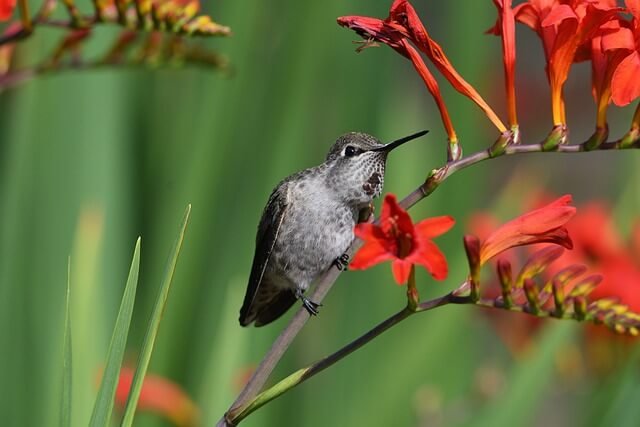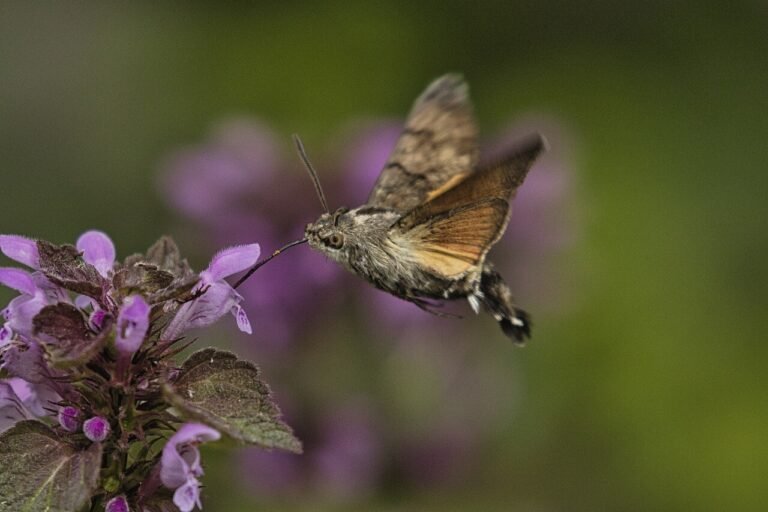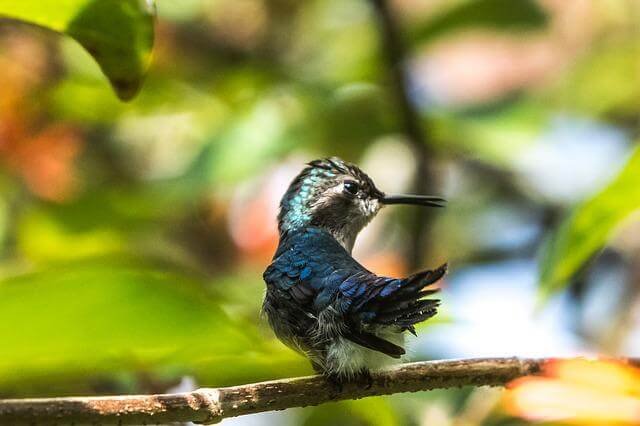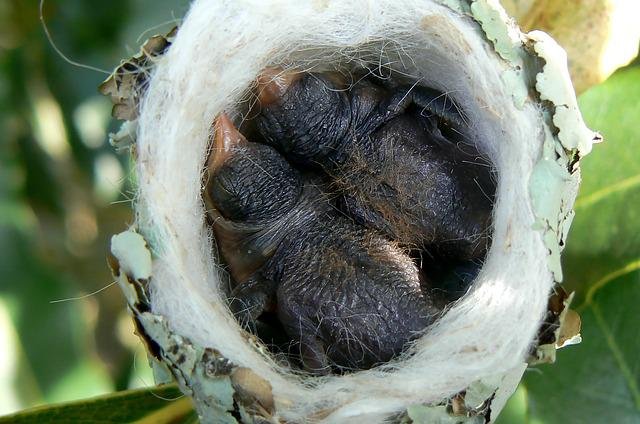Facts about Hummingbirds
Meet the helicopter of the animal kingdom. Hummingbirds are colorful birds and the tiniest birds in North America. They can hover and fly backwards, and they can even fly upside down.
Their wings are so fast we can barely see them moving. They have long beaks and tongues to drink nectar from flowers, but they also eat insects and spiders to get protein. And here are our favorite hummingbird facts!
Can Hummingbirds really fly backwards?
Have you ever wondered where Hummingbirds migrate to in the winter?
Well, we have the answer for you! Hummingbirds migrate south Mexico or Central America) in the winter and go back to the north in the summer. They fly at speeds of up to 50 miles per hour and cover more than 2,000 miles a day. Now you know where the hummingbirds are when it’s cold in the north!
If you want to see some fantastic birds this year, make sure to visit one of these locations known for its beautiful hummingbird populations. You won’t regret it!
Read on if you want to know more facts about hummingbirds!
How long do Hummingbirds live?
The average lifespan is about 4 years, but some can live up to 10 years! Reasons for a premature death can be flying against windows and buildings.
Dirty hummingbird feeders can be an avoidable cause of a bacterial infection that leads to the bird’s death. Feeders should be cleaned 1-2x each week with hot water. If necessary, mix hot water with a few drops of vinegar.
There’s one thing that all birds have in common – they’re always on the lookout for predators. Especially cats pose a significant danger to birds. Other predators are martens and hawks.
Hummingbirds Sleep Upside Down!
Ever wondered how birds sleep? Well, hummingbirds often sleep upside down, and it turns out that they don’t just sleep. These birds rest their eyes and take a break from flying around all day, by going into a state of torpor (similar to hibernation). When they do need to rest up for the night, they’ll find a nice tree branch or bush to spend the night on. And if there are no trees nearby, some will even sleep on your hummingbird feeder!
So next time you’re looking for something new in your yard or garden, think about adding a bird feeder, and some of these little guys might come and spend the night in your garden!
Why do Hummingbirds fight?
Hummingbirds are known for their beautiful colors and fast-paced flight.
But did you know they also have a tendency to get into fights with other birds? Guess why?
The answer is simple, really.
They’re just fighting because they’re defending their territory!

What is a Hummingbird moth?

Hint! It’s not a bird! The hummingbird moth is one of the most beautiful and fascinating insects in nature. They are found all over the world, but they’re especially common in North America.
Hummingbirds moths have some really cool features that make them so unique! For example, their wings beat at an incredible rate – up to 200 times per second! That’s faster than any other insect on Earth!
Hummingbird Size

Hummingbirds are the smallest birds in North America. They have a wingspan of about 5-6 inches and weigh less than an ounce. But don’t let their size fool you – they’re one of the most fascinating creatures on Earth!
What does a Hummingbird eat?
Hummingbirds have long, slender bills, and their tongues can extend up to 1 inch! These little guys love eating nectar from flowers and plants. But what food is on their diet besides nectar? They also enjoy insects like mosquitoes or spiders, centipedes, and other small insects! Yummy!
Can Hummingbirds walk?
Hummingbirds are the only birds that can fly backwards. They have a long, thin beak, and their wings flap so fast they’re almost invisible. Their feathers are iridescent and shimmer in all colors of the rainbow. But yes, they’re also able to walk!
Nesting and Mating
Hummingbirds don’t use nest boxes, but you can increase the chance of getting them to build nests by growing leafy trees like oak, hornbeam, or birch in your garden.

They start nesting and mating when they return from their winter migration. Females build a cup-shaped nest, made of spider silk, Lichen, or Moss, 10-40 feet above the ground, usually in forks of deciduous trees or shrubs. It will take 5-7 days until their nest is finished. They will lay two white eggs. The egg size depends on the species, but usually between 1.1 and 1.2 inches (2.8 – 3cm). The nestlings will hatch after 2-3 weeks of incubation. Mother hummingbird will feed them with small arthropods (small insects, spiders, centipedes) and nectar by inserting her bill and regurgitating the food into their crop
They probably the fastest tongue in the world
But how do they get that sweet liquid?
The tongue of a Hummingbird is perhaps one of the most fascinating tongues in the animal kingdom, and we’re not just talking about its speed. They have a unique adaptation that enables them to drink nectar from flowers with long corollas (like lilies) because they have an extendable tongue.
This allows them to reach as deep into flowers as bees do.
There are over 330 different species ...
There are over 330 different species of hummingbirds, and they’re found all over the world. Some live in tropical rainforests, some in deserts, and others near mountains. They can even be found on small islands!
Hummingbird wing speed
Hummingbirds are fascinating creatures with many unique qualities that make them stand out from other birds. Their wings which beat at an incredible rate of 80 times per second – which is about 10x faster than any other bird – are a great example!
Hummingbirds have one of the highest heart rates in the animal kingdom
They can beat up to 1,260 times per minute. That’s more than twice as fast as an average human! The high-speed flapping of their wings is what allows them to fly so quickly and hover in mid-air without tiring out.
It also helps them stay warm during cold nights by trapping air close to their body and releasing it when they’re hot.
The Hummingbird beak is not a straw
Despite popular belief, the beak of a hummingbird isn’t used as a straw. It’s also not as flexible as most other beaks are because it’s used as a protective sheath – to protect the long tongue. Hummingbirds use their tongue to get nectar out of flowers.
Flowers And Leafy Trees Are Their Natural Habitat
Hummingbirds are found in North America, South America, and Central America. They live indeciduous forests and gardens with flowers that have nectar. A hummingbird’s habitat is usually near water sources like ponds or streams because they need to drink often.

Creating a Hummingbird and butterfly garden
Do you want to attract hummingbirds and butterflies into your garden? You’ll need a few things before you can start attracting these beautiful creatures. First, make sure that the plants in your garden are native to the area where you live. Especially leafy trees with forks of branches make a hummingbird feel welcome. Second, make sure that there is plenty of water available at all times for both birds and insects. Third, be patient! It may take some time before they decide to come by, but it will definitely be worth it when they do!
Hummingbirds and butterflies are a fantastic addition to any garden because they provide beauty and pollination services for other flowers in your yard or nearby farms. They also help with pest control by eating pesky bugs like mosquitoes, so don’t forget about them next time you go shopping for new plants!

Get started today by planting native plants around your home or business and adding a feeder or two near trees with lots of leaves so that birds have shade from the sun while drinking water.
You can't keep Hummingbirds for a pet
One reason you can’t have a hummingbird pet is, because it’s prohibited in pretty much all states and countries to keep wild animals as pets, unless you have a special permit.
But even if you could, they would be terrible pets. They need feeding every 15 minutes and a lot of space to fly. The best way to enjoy them nearby is to get a hummingbird feeder for your yard.
What's the best way to get a Hummingbird feeder?
You can buy one, but it’s more fun to make your own! All you need is a glass jar and some sugar water. Fill up the jar with water and add 1 cup of sugar for every quart (that’s 0.9 liters or 4 cups) of water. Stir until all the sugar dissolves. Put in red flowers or other natural nectar sources near your feeder so that hummers will find it easily when they’re hungry. Don’t forget to clean or exchange it 2x a week, or your birds might die from an bacterial infection.
Hummingbirds are fascinating creatures, and watching them at their feeders is an unforgettable experience! They’re beautiful, fast-moving little birds who love nothing better than sipping on sweet nectar from a flower while hovering in mid-air like tiny helicopters. They also have excellent flying abilities – they can hover upside down as well as right side up!
Where to place Hummingbird feeders?
Is your backyard about to become a hummingbird hotspot?
Hummingbirds are the most popular birds in North America. They’re also one of the smallest, which means they need lots of nectar to keep their energy up. Luckily, there’s an easy way for you to help them out and make your backyard even more beautiful at the same time!
You can place a hummingbird feeder in your garden or flowers so that these tiny creatures have plenty of food. At the same time, they pollinate plants and enjoy themselves. It’s as simple as filling up a feeder with sugar water (or another type of sweet liquid) and hanging it from a tree branch or porch railing where it will be safe from cats, dogs, squirrels, etc.
How often should you change the Hummingbird feeder?
Depending on the weather, the feeder should be changed 1 – 2 times per week. If it’s hot outside, 2 changes are appropriate. On cold days, changing your hummingbird feeder once a week is enough. If you have pretty busy birds in your garden, clean and refill the feeder every time it’s empty. You can just use hot water to clean it.
Why are Hummingbird feeders red?
Hummingbirds love the color red. It’s a deep, rich hue that they can see from far away, and it attracts them to your feeder like nobody’s business. It’s probably because, in nature, red flowers are often full of delicious sweet nectar – the perfect food for our quick little friends.
Plus, it looks really pretty hanging on your porch or deck!

So if you want more hummingbirds in your life, get yourself a bright red feeder today!
Are Hummingbird feeders bad?
Actually no. They’re very helpful, and hummingbirds appreciate them. Birds have lost many natural food resources because of our growing cities and unnatural landscaping.
With that being said, hummingbird feeders can be harmful if poorly maintained, filled with bad food or if overrun by wasps, bees, or ants.
How to help injured birds?
We know that finding a wounded bird can be challenging to deal with.
If the bird is not in immediate danger, please call your local wildlife rehabilitation center for assistance and advice on how best to care for it.
You may also want to contact your state’s Wildlife or Department of Natural Resources if the injury appears serious or life-threatening.
